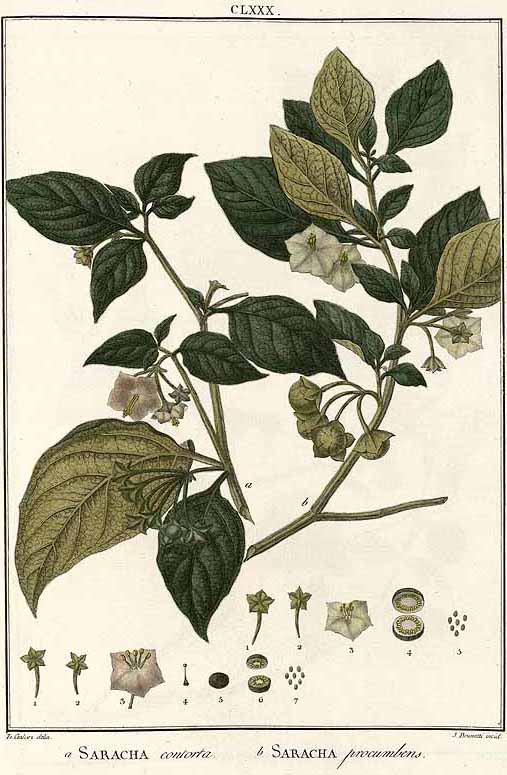
Figure 1.
Jaltomata contorta on left
herkogamy: note that staminal filaments are represented as angling away from the style, proximal to distal
Image presumably from Ruiz & Pavon's Flora Peruviana et Chilensis
Jaltomata contorta (R. & P.) Mione |
Peru |
revised 2022 |
The information on this page may be cited as a communication with professor Thomas Mione, Central Connecticut State University, Biology Department, Copernicus Hall, 1615 Stanley Street, New Britain, CT 06050-4010 USA, and Segundo Leiva G., Universidad Privada Antenor Orrego, Av. América Sur 3145, Casilla postal 1075, Trujillo, Peru |
Brittonia 51(1): 31-33. 1999. |
| Link to Jaltomata homepage | Literature cited in this website |
Link to reported medicinal use |
Link to table of Jaltomata species Department Lima, Peru |
 |
Figure 1. Jaltomata contorta on left
herkogamy: note that staminal filaments are represented as angling away from the style, proximal to distal
Image presumably from Ruiz & Pavon's Flora Peruviana et Chilensis
|
basionym: Saracha contorta R. & P., Fl. Peruv. et Chil. 2: 43. tab. 180. 1799. Type Collector & #: Ruiz fide the photospecimen at WIS Type Locality: Peru; Department Lima, province Canta, Obrajillo Date of type coll.: 3-7 Feb 1788 (information from book describing the travels of Ruiz & Pavon) Lectotype: G! Isolectotype: B-destroyed, F neg. 2549 G!, WIS! no type material is held by MA (Benitez de Rojas, Rev. Fac. Agron. [Maracay], IX(1):91-92, 1976) Redescribed: G. Don, Gen. Syst. 4: 452. 1838. Dunal, DC. Prodr. 13(1): 430. 1852. Synonyms: Distribution: At the herbarium MOL in Peru, Graciela Vilcapoma Segovia told Thomas Mione (year 2005) that she crisscrossed Obrajillo (Peru, Dept. Lima, province Canta), knowing the area intimately, and never found this species. As well, Segundo Leiva G., Leon Yacher and Thomas Mione were unable to find this species in the Obrajillo area. |